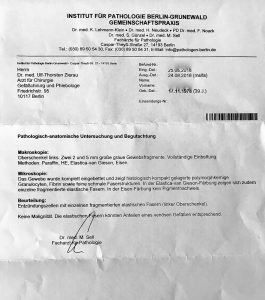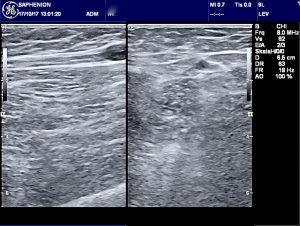Saphenion®: VenaSeal® 10 Jahre in der Vene?Venenkleber langfristig in der Vene nachweisbar?
Saphenion®: VenaSeal® 10 years inside the veins? Is vein glue detectable in the vein in the long term?
Saphenion®: VenaSeal® 10 Jahre in der Vene? In den letzten Jahren haben sich in den Medien und auf Webseiten Aussagen von Kollegen gehäuft, die den Venenkleber sehr populistisch bewerten und dabei auch nicht vor Schreckensbegriffen, wie: “ Unmengen von Chemie“, “ Sekundenkleber“ und „Gifteinspritzungen in die Vene“ zurückschrecken. Dabei wird bewusst negiert, dass es weltweit seit Mitte der 60er Jahre auch theoretische Forschungen zur Gewebeverträglichkeit, zum biologischen Abbau und zur Wirkung des Klebers „Cyanoacrylat“ gibt und auch die amerikanische Gesundheitsbehörde FDA 2015 umfangreiche Prüfprotokolle zum Einsatz in den Krampfadern veröffentlicht hat. Abgesehen davon, dass eben diese Prüfung bereits 2011 auch in der EU durchgeführt worden war. Inzwischen hat die FDA den Venenkleber „VenaSeal“ 2018 in den USA zu einer Versicherungsleistung erklärt.
Lately, in the media and on websites phrases of colleagues who rate the vein glue very populist and do not shrink from horrors such as: „tons of chemistry“, „superglue“ and „poison injections into the vein“. It is deliberately denied that there has been worldwide research since the mid-sixties on the tissue compatibility, biodegradation and the effect of the adhesive „cyanoacrylate“ The US Food and Drug Administration FDA 2015 has published extensive test protocols for use in varicose veins. Apart from the fact that just this test had already been carried out in 2011 in the EU. In the meantime, the FDA has declared the vein adhesive „VenaSeal“ 2018 in the USA an insurance benefit.
Saphenion®: VenaSeal® 10 Jahre in der Vene? Was ist dran an diesen Erklärungen?
Zum Einen sind inzwischen weltweit über 1,5 Mio. Patienten mit dem Kleber behandelt worden. Zum Zweiten werden je Stammkrampfader lediglich 1,5 – 1,8 ml des Klebers benötigt.
Dazu kommen – in regelmäßigen Abständen – ausgesprochen positive Erfahrungsberichte in der internationalen Fachpresse zu den klinischen – und Anwendungsergebnissen.
Die Basis des Venenklebers bildet – wie seit Beginn der 60er Jahre auch bei allen anderen operativen Einsatzgebieten – das Cyanoacrylat. Dieses wird jedoch chemisch so verändert und adaptiert, dass eine gute Gewebeverträglichkeit und eine Bioresorption erreicht werden.
Über die Bioresorption gut es inzwischen eine Reihe von Tierversuchen an Ziegen, Kaninchen und Albinoratten. Bisher fehlte allerdings der histopathologische Nachweis für die Bioresorption des Klebers in menschlichen Venen. Es wäre auch irre und ethisch nicht vertretbar, wenn man behandelte Patienten bitten würde, sich ein Stück der verklebten Vene zu Forschungszwecken entfernen zu lassen.
Saphenion®: VenaSeal® 10 years inside the veins? What’s wrong with these explanations?
On the one hand, more than 1,5 Mio patients worldwide have been treated with the vein glue. Secondly, only 1.5 – 1.8 ml of the glue is needed in the treatment of one truncal varicose vein.
In addition, there are – at regular intervals – very positive reports in the international scientific press on the clinical and application results.
The basis of the vein glue forms – as since the beginning of the 60s also in all other surgical areas – the cyanoacrylate. However, this is chemically altered and adapted for good tissue compatibility and bioresorption.
Bioresorption is good for several animal experiments on goats, rabbits, and albino rats. So far, however, lacked the histopathological evidence for the bioresorption of the adhesive in human veins. It would also be wrong and ethically unreasonable to ask treated patients to have a piece of the bonded vein removed for research purposes.
Saphenion®: Venenkleber 10 Jahre in der Vene?Eine eigene Fallbeschreibung zum Thema…
Vor 5 Jahren haben wir bei einer Patientin eine VenaSeal – Therapie simultan an beiden Stammvenen durchgeführt. Der post operative Verlauf verlief völlig unauffällig.
Nach 12 Monaten stellt sie sich dann mit einem ca. 1 cm grossen entzündeten Venenstrang der vormals verklebten Stammkrampfader am li. Oberschenkel vor. Nach zunächst konservativer Therapie mit entzündungshemmenden Medikamenten und Alkoholkompressionsverband entschieden wir uns nach 14 Tagen, den entzündeten Venenabschnitt nach guter alter Chirurgensitte mittels eines kleinen Einstichs zu entfernen. Wir entleerten den gesamten entzündeten Inhalt einschließlich der Venenreste und sandten diesen in ein Labor für Pathologie und Histologie. Natürlich gingen wir davon aus, dass in der Histologie auch Kleberbestandteile und – reste nachweisbar sein würden.
Saphenion®: VenaSeal 10 years inside the veins? A recent casuistry surprised us …
One year ago we performed VenaSeal therapy simultaneously on both truncal GSV in a female. The postoperative course was completely unremarkable.
After 12 months she then presents herself with a 1 cm varicose vein phlebitis of the formerly treated sealed vein on the left leg. After initially conservative therapy with anti-inflammatory drugs and an alcohol compression bandage we decided after 14 days to remove the inflamed venous section after a good old surgeon method using a small cut. We emptied all the inflamed contents, including the remains of the veins, and sent it to a laboratory for pathology and histology. Of course, we assumed that in histology also adhesive components and residues would be detectable.

Es hat uns dann doch überrascht, dass dies nicht der Fall war. Es wurden reichlich Entzündungszellen nachgewiesen, dazu Fibrin und elastische Fasern und Reste der Venenwand, jedoch kein Kleber oder andere Kunststoffe!
It surprised us then that this was not the case. There were plenty of inflammatory cells detected, plus fibrin and elastic fibers and remains of the vein wall, but no glue or other plastics!

Saphenion®: Venenkleber 10 Jahre in der Vene? Ultraschallbild von der behandelten Vene mit dem entzündeten Abschnitt
Damit haben wir, eigentlich eher zufällig, erstmals am Menschen einen Beweis für den biologischen Abbau des Venenklebers in den Händen. Wir fühlen uns demnach ein wenig bestätigt in der Therapieoption Venenkleber, die wir neben der Radiowelle und dem Mikroschaum anbieten. Und wir freuen uns darauf, dass vielleicht jetzt etwas sachlicher und unvoreingenommener über dieses seit 2011 praktizierte Verfahren diskutiert werden kann.
Und ich lade die Zweifler gerne ein, ein kleines Stück einer bei mir selbst verklebten Vene zu entfernen, um diese dann auch untersuchen zu lassen.
Thus, for the first time on humans, we have, for the first time, proof of the biodegradation of the vein glue in our hands. We therefore feel a little confirmed in the treatment option venecylar, which we offer in addition to the radio wave and the microfoam. And we are looking forward to discussing this factual and unprejudiced procedure, which has been practiced since 2011, perhaps now.
And I invite the doubters to remove a small piece of my sealed vein
Photos / Video: Utzius
Links / Papers:
Almeida JI, Murray SP, Romero ME. Saphenous vein histopathology 5.5 years after cyanoacrylate closure. J Vasc Surg Venous Lymphat Disord. 2020 Mar;8(2):280-284. doi: 10.1016/j.jvsv.2019.04.014. Epub 2019 Jul 4. PMID: 31281102.
Bahi M, Guazzo L, Taumoepeau L. Real-world short-term VenaSeal ablation outcomes for symptomatic saphenous incompetence. Vascular. 2023 Jun;31(3):521-525. doi: 10.1177/17085381221077511. Epub 2022 Feb 25. PMID: 35209758.
Epstein D, Bootun R, Diop M, Ortega-Ortega M, Lane TRA, Davies AH. Cost-effectiveness analysis of current varicose veins treatments. J Vasc Surg Venous Lymphat Disord. 2022 Mar;10(2):504-513.e7. doi: 10.1016/j.jvsv.2021.05.014. Epub 2021 Aug 25. PMID: 34450353.
Gibson K, Ferris B. Cyanoacrylate closure of incompetent great, small and accessory saphenous veins without the use of post-procedure compression: Initial outcomes of a post-market evaluation of the VenaSeal System (the WAVES Study). Vascular. 2017 Apr;25(2):149-156. doi: 10.1177/1708538116651014. Epub 2016 Jul 9. PMID: 27206470.
Lee C. The Novel Surgical Technique in the Cyanoacrylate Closure for Incompetent Great Saphenous Veins. Vasc Endovascular Surg. 2024 Jul;58(5):486-490. doi: 10.1177/15385744231225910. Epub 2023 Dec 28. PMID: 38155556.
Park I. Human Saphenous Vein Histopathology 2 Years After Cyanoacrylate Closure Using the VenaSeal™ System. Ann Vasc Surg. 2021 Feb;71:534.e17-534.e21. doi: 10.1016/j.avsg.2020.09.017. Epub 2020 Sep 16. PMID: 32949737.
Tang TY, Yap CJQ, Chan SL, Soon SXY, Yap HY, Lee SQW, Choke ETC, Chong TT. Early results of an Asian prospective multicenter VenaSeal real-world postmarket evaluation to investigate the efficacy and safety of cyanoacrylate endovenous ablation for varicose veins. J Vasc Surg Venous Lymphat Disord. 2021 Mar;9(2):335-345.e2. doi: 10.1016/j.jvsv.2020.03.020. Epub 2020 May 7. PMID: 32387378.
Türkmen U. Single-center clinical experience of cyanoacrylate embolization method for incompetent perforating veins in treating CEAP-6 patients. J Vasc Surg Venous Lymphat Disord. 2024 Nov;12(6):101939. doi: 10.1016/j.jvsv.2024.101939. Epub 2024 Jul 1. PMID: 38960130; PMCID: PMC11523291.
Whing J, Nandhra S, Nesbitt C, Stansby G. Interventions for great saphenous vein incompetence. Cochrane Database Syst Rev. 2021 Aug 11;8(8):CD005624. doi: 10.1002/14651858.CD005624.pub4. PMID: 34378180; PMCID: PMC8407488.
Yasim A, Eroglu E, Acipayam M, Ari M. Eight year results of patients with varicose vein underwent endovenous occlusion using n-butyl cyanoacrylate. Phlebology. 2025 Jul;40(6):395-399. doi: 10.1177/02683555241308699. Epub 2024 Dec 18. PMID: 39694880.
